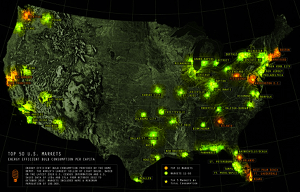
The final year of the incandescent light bulb phase-out began on Jan. 1, meaning manufacturers have already stopped producing traditional 40- and 60-watt bulbs. In keeping with a law passed by Congress in 2007, the phase-out started with the 100-watt incandescent in 2012 and progressed last year to the 75-watt variety, but experts say this final stage is the most significant.
Noah Horowitz, a senior scientist at the Natural Resources Defense Council, told National Geographic's energy blog that 40- and 60-watt bulbs represent "more than 50 percent of the [consumer lighting] market." While the sale and purchase of incandescents will continue until supplies run out, many consumers who have been slow to jump onboard with energy efficient alternatives may face a rude awakening in the near future.
With the last leg of the gradual phase-out already in effect, Home Depot released a data-driven map that uses sales numbers to create a per capita look at U.S. adoption of energy efficient bulbs. By combining the latest 2010 Census data with U.S. sales from 2012 through 2013, the home improvement giant compiled a list of the top 50 cities for efficient bulb adoption - revealing the locales that are leading the charge and areas that are still lagging behind.
The top 10 cities for energy efficient bulbs range from areas known for sustainability, such as Seattle and San Francisco, to smaller markets like West Palm Beach and Fort Lauderdale, Fla., according to the study. Eight of the top 10 markets offer rebates for either LEDs or CFLs, and four of those provide rebates for both. Although the study was limited to markets of 100,000 or more, the Midwest is noticeably absent from the list, as is a large portion of the Southeast.
Obviously, consumers purchase their bulbs from stores other than Home Depot, but the Atlanta-based retailer is the world's largest seller of light bulbs and operates more than 2,200 stores in the U.S. alone. So, while it may not be a definitive list of energy efficient bulb adopters, the Home Depot heat map surely represents a large part of the picture.
The so-called light bulb "ban" has become a favorite target of conservative pundits in recent years, but Home Depot isn't the only top company to come out in support of it. Walmart recently opened its first 100 percent LED lit store and launched a budget-friendly line of Great Value LED bulbs. Another major light bulb manufacturer, Phillips, publicly defended the phase-out back in 2012, despite controversy surrounding a 60-watt LED bulb that received $10 million in funding from the Department of Energy.
For more information on which cities fared best in the Home Depot study, look at the full heat map here.
Image credit: Home Depot

Mary has reported on sustainability and social impact for over a decade and now serves as executive editor of TriplePundit. She is also the general manager of TriplePundit's Brand Studio, which has worked with dozens of organizations on sustainability storytelling, and VP of content for TriplePundit's parent company 3BL.














